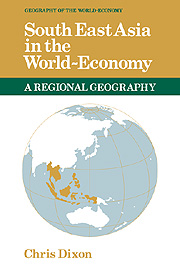Book contents
- Frontmatter
- Contents
- List of figures
- List of maps
- List of tables
- Acknowledgements
- Sources and place names
- List of abbreviations
- 1 Contemporary South East Asia in the world-economy
- 2 Pre-colonial South East Asia
- 3 Western penetration: from trade to colonial annexation
- 4 Uneven development: the establishment of capitalist production
- 5 Development strategies and the international economy
- 6 South East Asia in the late twentieth century: problems and perspectives
- Notes
- References
- Index
5 - Development strategies and the international economy
Published online by Cambridge University Press: 22 September 2009
- Frontmatter
- Contents
- List of figures
- List of maps
- List of tables
- Acknowledgements
- Sources and place names
- List of abbreviations
- 1 Contemporary South East Asia in the world-economy
- 2 Pre-colonial South East Asia
- 3 Western penetration: from trade to colonial annexation
- 4 Uneven development: the establishment of capitalist production
- 5 Development strategies and the international economy
- 6 South East Asia in the late twentieth century: problems and perspectives
- Notes
- References
- Index
Summary
Overview of South East Asian development strategies
This chapter examines the development strategies followed by the capitalist states of South East Asia since the 1950s in the context of their changing interaction with the world-economy. Major changes in policy show considerable similarity in form and timing throughout the region. This reflects the generally ‘open’ nature of the capitalist South East Asian economies, their high degree of interaction with the world-economy and their receptiveness to changes in the prevailing development ‘orthodoxy’, in particular through the advocacy of the IBRD and IMF. However, this changing orthodoxy is itself a reflection of change in the world-economy and indeed trails behind such changes.
Since the 1950s economic development strategies in all the pro-capitalist South East Asian states have emphasised rapid urban-industrial development. In addition as Hardjono (1983: 33) has noted: ‘insecure governments tend to concentrate their resources upon urban improvements in the interests of maintaining their own power and winning international recognition, of their country's status as a self governing nation’. Rural development has played an increasingly secondary role; although, in all the states except Singapore the rural areas have continued to receive a large proportion of development funds, it has generally been substantially less than their shares of the population and GDP.
Rural insurgency, particularly in Thailand and the Philippines and the strength of rural political lobbies, notably in Malaysia, have a significant part in maintaining expenditure on the rural sector.
- Type
- Chapter
- Information
- South East Asia in the World-Economy , pp. 149 - 216Publisher: Cambridge University PressPrint publication year: 1991



